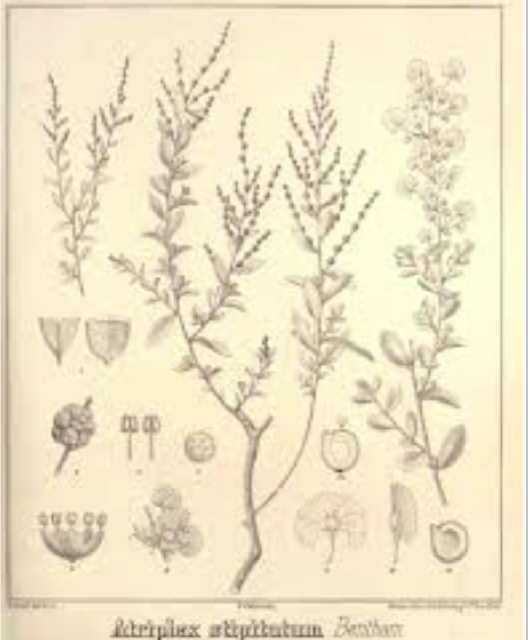Once we have identified our plants the painting begins. In this series Roslyn Glow will take us through the process she uses to create her botanical portrait of Atriplex stipitata
Roslyn's description was written for our honorary botanist, Andrew Denham, and she has allowed it to be reprinted here. This first part was published on the bog last year. We will publish the whole series over the next few weeks.
 |
| Saltbush country (Photo copyright: Anne Lawson, 2016) |
Getting to know the plant
Atriplex stipitata (Bitter saltbush, Mallee saltbush, Kidney saltbush) is a modest subject, but I know from experience that, no matter what my initial reaction, by the time I have studied a plant and found out a bit about how it makes its living and the history of its discovery, I will undoubtedly find it fascinating.
I turn the specimens around, and view them from every angle. Because very little material is available in this case, I have little to choose from. I try to identify the male and female flowers. The female flowers are hard to identify. They are said to occur singly or a few together in the leaf axils. I paste various parts of the plant onto a scrap-book page, using book covering film.
 |
| My specimen of Atriplex stipitata (Photo copyright: Roslyn Glow, 2015) |
 |
| Scratch pad page with pasted parts of the plant, colour swatches and sketches of plant parts (Photo copyright: Roslyn Glow, 2015) |
That night, I use my iPad to research the plant. Next day I copy the most important identifying features of the plant onto my sketchpad. I am interested to find that this species can be monoecious or dioecious. Mine is dioecious, that is male and female flowers are on separate plants.
The “Picture Book” (Cunningham et al) has a picture of my plant, and a drawing of the fruit. I trace this drawing onto my sketchpad.
I note that my specimen’s leaves are partially closed, while the photos on the internet show the leaves as more or less flat. Eventually I discover the reason for this. When the soil is very dry, the leaves close, presumably to help conserve moisture. My specimens were clearly thirsty.
Google finds me plenty of photos of A. stipitata but no paintings, and few
drawings. The only comprehensive one is by Margaret Flockton, (1861-1953) the first person employed in Australia as a botanical illustrator.
It is possible that an unpublished collection of paintings of the plants of the Broken Hill area, held in the National Library in Canberra, includes a painting of A. stipitata, but I can’t be certain of this.
Next time Roslyn will show us how she composes and selects the right colours for her painting.
 |
| A. stipitata by Margaret Flockton |
Next time Roslyn will show us how she composes and selects the right colours for her painting.
No comments:
Post a Comment
Add your thoughts.....we would love to hear what you have to say!